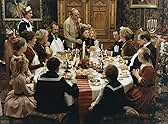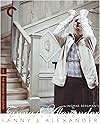PUNTUACIÓN EN IMDb
7,5/10
1,1 mil
TU PUNTUACIÓN
Una crónica de la realización de la película de Ingmar Bergman ganadora de un premio Oscar.Una crónica de la realización de la película de Ingmar Bergman ganadora de un premio Oscar.Una crónica de la realización de la película de Ingmar Bergman ganadora de un premio Oscar.
- Dirección
- Guión
- Reparto principal
Reseñas destacadas
While I can see the interest in seeing Ingmar Bergman and Sven Nyqvist behind the camera and at work, there has to be a little more to it than having a second cinematographer run a camera on the crew to make two films (the film and this doc) at once for the price of one. Dokument Fanny och Alexander provides bits and pieces of interesting, valuable material, but is lacking in many respects. It focuses on Bergman and Nyvqist behind the camera, but provides very little insight into the genesis of the story, its meanings, or any of the other crew: nothing on Asp's vision or Vos' work, nothing from the cast about how they approached their work. The doc A Bergman Tapestry, also included in Criterion's Blu-ray, is more valuable and well-rounded in that regard.
As for what we see, it doesn't take long for things to get repetitive. Did we really have to see that clown with the candle on his head *that* many times?
As for what we see, it doesn't take long for things to get repetitive. Did we really have to see that clown with the candle on his head *that* many times?
Making of Fanny and Alexander, The (1986)
**** (out of 4)
Four years after Fanny and Alexander was released, director Bergman released this documentary that gives us a behind the scenes look at how the legendary master put together his (at the time) last masterpiece. I think this documentary could rank right up there with Bergman's greatest pictures because it features a lot of the stuff that his movies are so well known for. Watching how Bergman films certain scenes, like the pillow fight, where he goes back and forth on what he wants. In this scene he's debating whether the children should be wearing slippers or not. He decides they shouldn't be but then he worried about one of the kids slipping and hurting themselves. We also get to see more difficult scenes like the dying scene in the movie where he must direct twelve of the actors for a very hard shot. What's even more special are the scenes where Bergman is taking it easy and just chatting with the cast and crew. It's also great fun watching the master discuss shots with (the other master) Sven Nkvist. You can see how hard working both men are and it's rather amazing that neither killed the other. If you're a fan of Fanny and Alexander than this is a must see. If you're simply interested in how movies are made then this is one of the best documentaries out there.
**** (out of 4)
Four years after Fanny and Alexander was released, director Bergman released this documentary that gives us a behind the scenes look at how the legendary master put together his (at the time) last masterpiece. I think this documentary could rank right up there with Bergman's greatest pictures because it features a lot of the stuff that his movies are so well known for. Watching how Bergman films certain scenes, like the pillow fight, where he goes back and forth on what he wants. In this scene he's debating whether the children should be wearing slippers or not. He decides they shouldn't be but then he worried about one of the kids slipping and hurting themselves. We also get to see more difficult scenes like the dying scene in the movie where he must direct twelve of the actors for a very hard shot. What's even more special are the scenes where Bergman is taking it easy and just chatting with the cast and crew. It's also great fun watching the master discuss shots with (the other master) Sven Nkvist. You can see how hard working both men are and it's rather amazing that neither killed the other. If you're a fan of Fanny and Alexander than this is a must see. If you're simply interested in how movies are made then this is one of the best documentaries out there.
The next best thing to watching Bergman's films is for me to watch and listen to him talking about himself and about his works. "Making of" is a fascinating document - I always wanted to know how he makes his films, what is behind the poetry of images and the sound of silence. Following the master's steps, watching the most magical scenes born in front of you, seeing him in control of his production, always knowing what he wants and leading his crew and his actors; his longtime friendship with his legendary cinematographer Swen Nykwist to the point that they don't talk much - they don't need many words to understand each other - all of these made "Making of Fanny and Alexander" absolutely unique and amazing experience for me. The birth of each scene is a miracle but some of them stand out. The first is one of the most enigmatic and magical scenes ever and not only in Bergman's films - night scene in the Isak's house between Alexander and Ismael, a completely mysterious character with supernatural psychic powers who helped Alexander to unleash his own powers he never knew he had.
The second is the scene with Gunnar Björnstrand, one of the most versatile Bergman's actors (Höstsonaten, (1978), Ansikte mot ansikte (1976), Skammen (1968), Persona (1966), Nattvardsgästerna (1963), Såsom i en spegel (1961), Ansiktet (1958), Smultronstället (1957), Sommarnattens leende (1955), and his masterpiece Det Sjunde inseglet, (1957)). He was old and apparently ill while making Fanny and Alexander which was his last film. The scene in "Making of..." is almost 20 minutes long and shows over and over how Bergman rehearses a short, perhaps one or two minute long cameo with Björnstrand as clown Feste in Shakespeare's "Twelfth Night". It is painful to watch a great actor in such a pitiful state. At some point you'd want Bergman to stop what seems like a torture but he goes on, encouraging his friend, praising him, making sure that Gunnar feels comfortable but not stopping before the scene is shot to his liking...
The second is the scene with Gunnar Björnstrand, one of the most versatile Bergman's actors (Höstsonaten, (1978), Ansikte mot ansikte (1976), Skammen (1968), Persona (1966), Nattvardsgästerna (1963), Såsom i en spegel (1961), Ansiktet (1958), Smultronstället (1957), Sommarnattens leende (1955), and his masterpiece Det Sjunde inseglet, (1957)). He was old and apparently ill while making Fanny and Alexander which was his last film. The scene in "Making of..." is almost 20 minutes long and shows over and over how Bergman rehearses a short, perhaps one or two minute long cameo with Björnstrand as clown Feste in Shakespeare's "Twelfth Night". It is painful to watch a great actor in such a pitiful state. At some point you'd want Bergman to stop what seems like a torture but he goes on, encouraging his friend, praising him, making sure that Gunnar feels comfortable but not stopping before the scene is shot to his liking...
10iF....
This is a documentary to see if you are interested in how movies are made. Seeing the master filmmaker Ingmar Bergman direct his last movie was so sentimental yet sad. During certain scenes he was directing, you could see REAL drama in the actor's faces whenever they tried their best to impress Bergman. You could see a sense of humanity and the close relationship between the people on set. See this film, you won't be disappointed.
While the making of Ingmar Bergman's last film, Fanny and Alexander, has been available on video for some time, that it is now available along-side the new American DVD release of the TV series/Theatrical cuts makes it essential viewing. Along with an interview as a bonus feature with Bergman in 1984, the film acts like a kind of sequel to another director's documentary- "Ingmar Bergman Makes a Movie"- which charted his production of Winter Light.
For Fanny and Alexander, we as the audience get an evolutionary look at the production, from out-door scenes simply involving a horse and carriage, to the elaborate, joyous Christmas and Christening dinners, and to the dead silent, dead serious scenes involving the tragedies in the story. The inter-titles put in by Bergman himself in-between the segments is another unexpected treat- as he comments on what's going on with the actors and the set-ups, there is a little humor here and there (i.e. a reference to a high church official who got upset about an incident involving a TV antenna).
And like with the previous documentary on Winter Light, Document of Fanny and Alexander provides for Bergman and non-Bergman fans alike to see what goes into the directorial/shooting process. How does a director talk to the actors? How does the director of photography (as with the previous film, the master Sven Nykvist) fit into shaping the scenes? And is the mood always completely focused, or does a shot of excitement over the process get over them (in other words, what's the mood)?
These kinds of questions are answered with an unflinching eye for the viewer, and at worst can only make the filming process to be boring (which it can be). But for a behind-the-scenes venture, there's a lot worse out there.
For Fanny and Alexander, we as the audience get an evolutionary look at the production, from out-door scenes simply involving a horse and carriage, to the elaborate, joyous Christmas and Christening dinners, and to the dead silent, dead serious scenes involving the tragedies in the story. The inter-titles put in by Bergman himself in-between the segments is another unexpected treat- as he comments on what's going on with the actors and the set-ups, there is a little humor here and there (i.e. a reference to a high church official who got upset about an incident involving a TV antenna).
And like with the previous documentary on Winter Light, Document of Fanny and Alexander provides for Bergman and non-Bergman fans alike to see what goes into the directorial/shooting process. How does a director talk to the actors? How does the director of photography (as with the previous film, the master Sven Nykvist) fit into shaping the scenes? And is the mood always completely focused, or does a shot of excitement over the process get over them (in other words, what's the mood)?
These kinds of questions are answered with an unflinching eye for the viewer, and at worst can only make the filming process to be boring (which it can be). But for a behind-the-scenes venture, there's a lot worse out there.
¿Sabías que...?
- CuriosidadesThis film is part of the Criterion Collection, spine #264.
- ConexionesEdited from Fanny y Alexander (1982)
Selecciones populares
Inicia sesión para calificar y añadir a tu lista para recibir recomendaciones personalizadas
Detalles
- Fecha de lanzamiento
- País de origen
- Idioma
- Títulos en diferentes países
- The Making of Fanny and Alexander
- Localizaciones del rodaje
- Empresas productoras
- Ver más compañías en los créditos en IMDbPro
Contribuir a esta página
Sugerir un cambio o añadir el contenido que falta











